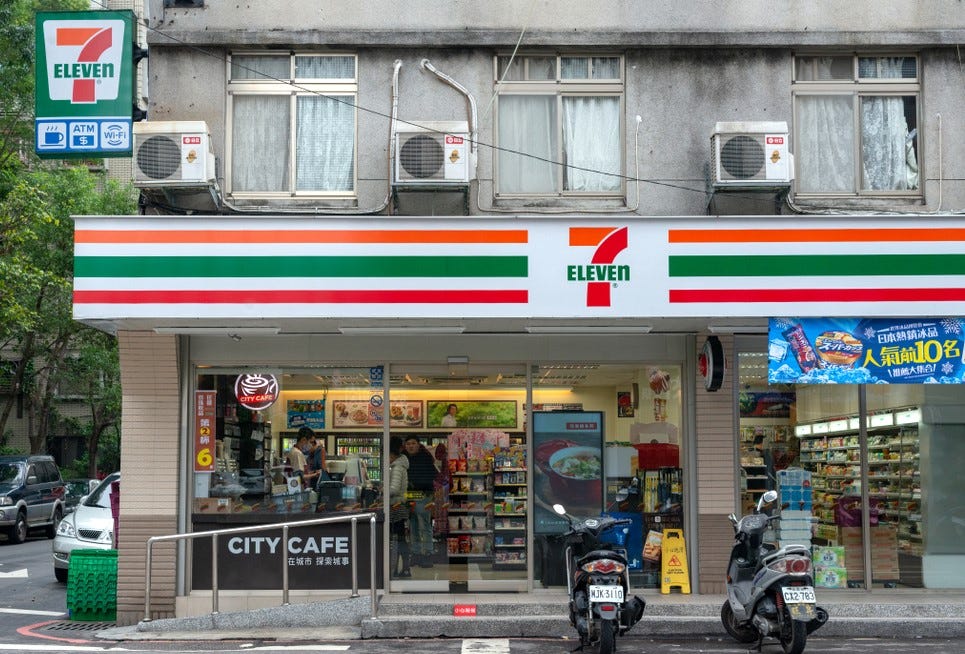
Plastic seat creaks under me as the hum of the fan increases as it cranes its neck back towards me. It’s a sweltering hot afternoon where you can barely see the shadow of the chained-up bicycles or the zipping past mopeds outside the thumb-smudged wide breadth windows on my left. The view of the mountain in the other window is certainly a redeeming character but nonetheless it feels like the solar rays are seeping through this box shaped structure called 7-Eleven. I’m on the second floor with the thought that I’d escape this heat and the boredom of having-no-plan after class and a lot of work that I think I should get started on. But a special kind of heat is formed when your lower back and butt touch a plastic chair that just takes away the mood, and this was probably not the best place to be right now anyways. I just thought I’d be like a Taiwanese student up here, chilling here and having a packaged snack, but I’m the only one, besides the older gentlemen with a newspaper fanned out in front of his face (maybe to keep cool as well?).
This piece of creative writing describes an experience I had abroad at a 7-Eleven near my school in Tamsui, Taiwan. Convenience stores like FamilyMart and 7-Eleven are ubiquitous in Taiwan, and I wanted to explore why, and in what ways they are impactful through my first-hand and in-class experiences. As a part of the intensive language study program, we had textbooks that included Taiwan-specific topics such as: hurricanes and typhoons, Taiwanese indigenous ethic groups, public transportation, and convenience stores and food culture, among others. I was particularly interested in convenience stores because it’s one of the things you hear about and notice immediately as a foreigner. They contain a lot more options, items, and services than in the U.S. Some highlights from my time there include photo printing services, blue ice cream, and chicken and spicy-flavored boiled eggs. In the chapter we studied in class (and most chapters about Taiwan-specific things) convenience stores were presented positively, almost as a cornucopia and innovation of modern Taiwan. While this is true in many respects, staying in the northern port city of Tamsui was interesting because of its historical character. However, this feeling and character that I saw there I also witnessed in Taipei proper. There were certainly modern shopping centers, stores, and high-rise buildings, but there’s also a lot of 80s era buildings and ground level mom-and-pop stores. To me, this is what maintained a sense of locality, authenticity, and “everydayness.” Particularly in Tamsui, local culture was prevalent and what drew people there, so learning about these convenience stores while engaged in a different environment was a bit of a disconnect. This is why I included this exposé on the barren and sweltering second floor 7-eleven. In this particular environment it felt out of place and perhaps imposing on the rest of the area. I found that I gravitated towards eating at local places and forming personal relations if I could. For example, my roommate and I frequented one breakfast spot, I almost always got lunch from a bento box stand near the university, and I liked to get dinner from another stand not far from my dorm. But I also wondered whether the influx of western money was appreciated by these local business owners or whether we were contributing to a steady rise in displacement, with further “modernizations” that the convenience stores represented. Was our class teaching us about the modern Taiwan so as to help precipitate that change? I spoke with the woman who ran the lunch stand I often went to and she described her preference for cooking herself or going to a convenience store in a rush. Maybe the “local” scene was shifting and changing? Outside of the sense I got from the class material and a single account, I can’t say I know for sure as well as not having asked specifically while I was there. But in general, learning about convenience stores in the classroom grounded what I saw in real life, and made me realize how important local restaurants and businesses are to Taiwan’s economy, and I questioned whether the process of change and modernization espoused is an ongoing fact, ideal, or opportunity, and who considers it as such.
Citation:
PracticalDreamer. “A Rather Ordinary Day for a Not-So-Ordinary 7-Eleven Employee in Taiwan.” Medium, September 20, 2023. https://medium.com/@yllynn.chen/a-rather-ordinary-day-for-a-not-so-ordinary-7-eleven-employee-in-taiwan-ed353118c23d.

Leave a Reply